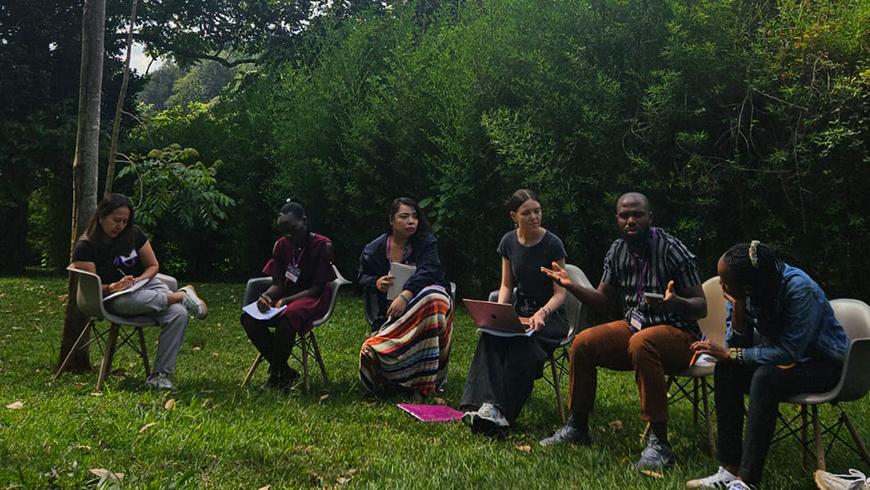The critical importance of self-care and wellbeing for EiE practitioners

Education in Emergencies (EiE) professionals operate in demanding, high-stress environments—often navigating war, displacement, trauma, and long-term uncertainty. While their work is vital for communities, it can also take a serious toll on personal health. Yet amid the urgency, one truth remains constant: We cannot pour from an empty cup.
Sustainable impact begins with a strong inner foundation. In the long arc of EiE work, inner strength isn’t just helpful—it’s essential.
The cost of overcommitment
Many of us have internalized the belief that if we support others, we don’t need support ourselves, falling into patterns that appear noble but quietly undermine our wellbeing:
“I don’t need life-work balance because I love my work.”
“Sometimes I forget to eat, sleep, or even drink water because I’m so busy with my work.”
“My students’ / clients’ problems and needs are more urgent than my own.”
These beliefs may stem from deep care and commitment, but they often lead to burnout, compassion fatigue, and emotional exhaustion. There’s also the persistent guilt:
“I can't rest knowing that others are struggling now.”
“I often work overtime to help others as effectively as I possibly can.”
When we sacrifice our health and boundaries in service of others, we risk losing the clarity and strength that make our support meaningful in the first place. The truth is simple and powerful: Taking care of yourself isn’t selfish—it’s the first step in caring for others.
Redefining self-care and wellbeing
So what do we mean by self-care and wellbeing in the context of EiE?
- Self-care refers to intentional actions that support mental, emotional, and physical health.
- Wellbeing is a holistic state of being healthy, comfortable, and content.
These are not indulgences. They are essential practices for people working under high stress and with vulnerable populations. Self-care includes rest, boundaries, reflection, mindfulness, and knowing when to seek support.
Stress is a part of life, and we all have resources to cope with it. The goal is not to eliminate stress entirely—but to recognize it, respond with awareness, and build habits that support resilience.
Tools for strengthening the inner core
1. The BASIC Ph Coping Model
The BASIC Ph model is a psychological framework developed by Professor Mooli Lahad to understand how people cope with stress and trauma. It identifies six core coping channels:
- B – Belief: Spirituality, values, and meaning-making
- A – Affect: Emotional expression (e.g., crying, laughing)
- S – Social: Connection, support, talking with others
- I – Imagination: Creativity, visualization, play
- C – Cognition: Logic, problem-solving, planning
- Ph – Physical: Movement, sports, hands-on tasks
Each person tends to favour 2–3 of these when facing stress. Recognizing and strengthening your dominant styles can help you cope more effectively. Find more practical tips and take a quiz to help you identify your dominant styles here.
2. The Wellness Wheel
Wellbeing is multi-dimensional. One useful tool is the Wellness Wheel or the Wheel of Wellbeing—a visual tool that helps you assess and balance different areas of your life. It includes eight dimensions of wellbeing:
- Emotional (love and belonging, understanding and expressing your emotions)
- Physical (health, caring of your body, rest, nutrition)
- Spiritual (connecting with values, beliefs, or a deeper sense of meaning)
- Social (building supportive and meaningful relationships)
- Intellectual (stimulating your mind and staying curious)
- Occupational (career, finding purpose and satisfaction in your work)
- Financial (managing money with confidence and security)
- Environmental (living in harmony with your surroundings)
By rating satisfaction in each area (1–10) and visualizing balance, you can identify areas that need attention and set small, realistic goals for improvement. While it’s not necessary to aim for a perfect 10 in every area, focusing on lower-rated dimensions can bring more balance to your life and help reinforce your inner resilience.
Use the Wellness Wheel Worksheet to explore the eight dimensions of your wellbeing, or try a quick online assessment based on the simplified Wheel of Life to get a snapshot of your current balance.
3. Daily and Weekly Practices
Inner strength isn’t built in grand gestures. It grows from daily and weekly rhythms, such as:
- Morning routines: journaling, meditation, quiet time
- Hourly breaks and hydration
- Consistent sleep and nourishing meals
- Regular movement or walks
- Talking with a mentor or peer
- Practicing gratitude and reflection
Even 10 minutes a day of intentional self-care can create meaningful change over time.
Use this worksheet to create your own Self-Care Menu—a personalized list of practices that can support your wellbeing, whether you have five minutes or a full hour for self-care today.
4. Creating a Culture of Care
While personal self-care is essential, the environment we work in plays a critical role in sustaining wellbeing. A culture of care means embedding supportive practices at all levels of an organization. This includes:
- Leaders who model healthy boundaries and balance—making self-care visible and acceptable
- Policies that allow mental health days and flexible schedules
- Access to psychological and emotional support, such as counselling or reflective supervision
- Peer support systems and developing supportive professional environments, like buddy check-ins or group reflection spaces
- Ongoing professional development focused on wellbeing and resilience
To make wellbeing sustainable, it must be normalized, resourced, and regularly practiced—not treated as a bonus or personal luxury. Teams thrive when self-care is seen not as individual weakness, but as a shared responsibility that strengthens collective impact.
Take a moment to reflect
After reading this article, before moving on, take a moment to pause and check in with yourself. To turn self-care into real, meaningful action, ask:
- What new self-care practice will I begin this week?
- What habit, belief, or behaviour is no longer serving me and can I let it go?
- What commitment will I make to support my own wellbeing?
You don’t need to change everything at once. Start with one small, intentional step. The key is consistency, not perfection.
Self-care is not a luxury, it’s a responsibility
The work we do in EiE is both deeply human and deeply demanding. To stay effective and present, we need to treat self-care not as a luxury, but as a foundation. Let’s reject the myths that rest is weakness or that wellbeing is optional. Let’s strengthen our inner core so we can continue to offer not just presence, but sustained, resilient impact.
Because in the work of care, our wellbeing is part of the solution.



